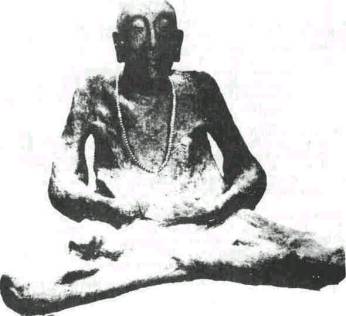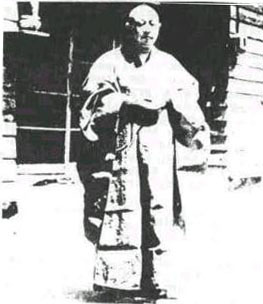|
In
1945 he served as the Guest Prefect at Ku Te Monastery. After the
Communist regime came into power in 1949 in China, he sought asylum in
Hong Kong and dwelled there in the Eastern P'u T'o Monastery. While he was
living in Hong Kong he was very active in relief projects to aid other
refugees from the Mainland sangha, and also at this time met the Venerable
Master Hua. In 1954 he embarked for Taiwan and took up residence at Shih
P'u Monastery in Taipei. Two years later he traveled to Chia Yi in the
south of Taiwan and there established Vulture Peak Eternal Light
Monastery. In 1961 he returned to the north and founded Sea Treasury
Monastery at Pi T'an, Taipei, and at the same time organized "The
Longevity Liberation of Life Association" in order to fulfill his
Great Vehicle Bodhisattva spirit of liberating and converting fishes and
terrestrial animals.
Basically,
in accord with the principles of conditioned existence, what is born must
die; the body must eventually disintegrate and decay. However, Dharma
Master Ch'ing Yen achieved the "whole body sharira" and although
his breath has ceased, his body remains among humankind as a testimony to
the power of the spirit over the flesh and as an expedient for leading
people to believe in the teachings of the Buddha.
His
disciple Ch'ang Ming said, "When the Great Master was in the world he
planned to establish a Pure Land Bodhimanda similar to the one on Ling Yen
Mountain in Soochow to comply with the need of people to expediently
cultivate the easy path in the Dharma-ending age. This fully reveals the
magnitude of Dharma Master Ch'ing Yen's compassionate vows."
WHY
DOESN'T THE BODY OF DHARMA MASTER CH'ING YEN DECAY?
The jar
which held the body of Dharma Master Ch'ing Yen and was interred on Thumb
Mountain in Taipei six years ago was opened in the presence of the public
on January 21, 1976. The body was found intact. When people heard the
news, they thronged to pay their respects. The Chinese Buddhist
Association under the directives of Upasika Sun Kuo-an (whose biography
appears in this issue in The Bodhi Lectern) made arrangements to
accommodate crowds numbering in the thousands that assembled to view the
flesh body. The Association was able to anticipate the reaction of the
public, for seventeen years ago great numbers of people made the ascent of
Hsiu Feng Mountain to gaze in veneration at the flesh body of the Great
Master Tz'u Hang.
The
remains of Great Master T'zu Hang were buried behind Maitreya's Inner
Court Monastery on Hsiu Feng Mountain in Hsi Chih, which is in the
vicinity of Taipei. In compliance with his wishes his disciples exhumed
the jar after five years and found his body in perfect condition. His skin
is partially transparent, his facial features are distinct, his arms hang
down at his sides, and his legs are in the full lotus posture. Since five
years had elapsed since his passing when the jar was opened, the water in
the body has evaporated and it therefore appears lean. The hair, which was
shaved before he completed the stillness, has grown back, and his eyebrows
are longer and thicker. The skin is as soft as that of a living person.
The nostrils, mouth, tongue, and teeth are all intact. The condition of
Dharma Master Ch'ing Yen's body is identical with that of Great Master
T'zu Hang's.
Some
people assume that the flesh bodies of these two Dharma Masters are like
Egyptian mummies. This is absolutely wrong. There are four peculiarities
about the Egyptian mummy: 1) the five principal internal organs are
removed; 2) the remains are embalmed with preservatives and spices; 3)
children and lean people are suitable for mummification; 4) the mummy is
stiff. The flesh bodies of Dharma Masters T'zu Hang and Ch'ing Yen display
characteristics which are opposite to those of the mummy. Both of them
were stocky persons of medium size. Dharma Master T'zu Hang greatly
resembled Maitreya Bodhisattva when he sat down. Their remains were placed
in jars; the internal organs were not removed, and the bodies were not
embalmed with decay-preventing agents. After the jars were opened, the
bodies were not stiff.
As a
matter of fact, there is nothing mysterious about this. There are six
indispensable conditions, which enable the Buddhist adept to prevent the
body from decaying. They are the following:
1)
Strengthened power of precepts. There are two hundred and fifty precepts
for the Mahayana Bhikshu. Four of the most fundamental precepts prohibit
killing, stealing, sexual activity, and lying. Dharma Masters T'zu Hang
and Ch'ing Yen left the home life when they were young. They never had
close contact with women, and they therefore kept their virginity. The
undecayed flesh body results from holding the precept against sexual
activity and cutting off all desire.
2)
Strengthened power of samadhi. By samadhi here is meant the power of
concentration obtained by sitting in meditation. If the skill of dhyana
concentration is deep it causes extreme, transfiguring changes in the body
which occur in a manner analogous to the process of refining iron into
steel. The wisdom and the spiritual penetrations described in Buddhist
texts are realized through dhyana samadhi cultivated in accord with the
teachings. Dharma Master T'zu Hang foretold the date of his death
ten years before it occurred. Dharma Master Ch'ing Yen knew when his time
had come and one month before he died he gave instructions to his
disciples to place his body in the jar and open it six years later. They
attained this prescience through dhyana samadhi.
3)
Strengthened power of faith. In the sutras it says, "Faith is the
source of the Way and the mother of merit and virtue which nourishes all
good roots." Those who cultivate and study the Buddhadharma should
have lofty convictions. They should believe that the myriad of existence
in the universe is imbued with true principle; that the merit and virtue
of the Triple Jewel is vast and profound; that the power of good and evil
cause and effect is great; and that their minds are just the Buddha. They
strongly believe that if the patriarchs can keep their bodies intact after
death, they can do so too. "If the mind of faith is pure and clean,
the true mark is produced." This is why the body of the Sixth
Patriarch Hui Neng of the Ch'an school has stayed intact for more than one
thousand years. The flesh bodies of Earth Store King Bodhisattva on Nine
Flowers Mountain in An Hui, of Great Masters Shin T'ou, Tan T'ien, Han
Shan and others are also the true proof of actual practice.

The
flesh body of Dharma Master Ch'ing Yen.
4) Strengthened power of vows. "Vow power" in Buddhist usage is
what is ordinarily called "will." Will is one of the highest
faculties of the spirit; without strong will power and determination
little can be accomplished. One should, always be mindful of one's vows.
Where wholehearted dedication is directed, the whole world will step aside
to let one by. Both Dharma Masters T'zu Hang and Ch'ing Yen had made great
vows to attain vajra indestructible bodies in order to take living beings
in the Saha world across.
5) Aid from the
power of the Buddhas. A cultivator can not solely rely on his own power,
for it is not sufficient. He has to depend on "external" power
too, the power of the Buddha. The disciple should revere his patriarch and
take his teacher as a model. The power of the patriarch is imperceptibly
transmitted to his disciple and gives the latter the spiritual strength
which elicits the aid of the Buddhas.
6) Aid from the
power of the Dharma. Sutras and mantras are Buddhadharma. If one recites
sutras and mantras everyday their efficaciousness cap keep one's mind free
from confusion and increase one's blessings and wisdom. Dharma Masters
Tz'u Hang and Ch'ing Yen got up at midnight to meditate, and from four in
the morning to nine at night they bowed to the Buddhas, recited sutras,
and held mantras. They were courageously vigorous and never retreated from
their resolve for the Way until they certified to the fruit.
---------------------------------------------------------------
People who
cultivate can become Buddhas. If you do not cultivate you can become a
ghost, an animal, or go to the hells. It is said:
Good
and bad are two different roads;
You
can cultivate or you can commit of tenses.
That is why it is
said that becoming a Buddha is done by oneself. No one else can do it for
you. It is also said that everything is made from the mind alone.
If
people wish to know
The
Buddhas of the three periods of time
They
should regard the nature of the Dharmarealm
Everything
is made from mind alone.
If you understand
proper Dharma you are in a state of true suchness and are not at all
upside-down. If something should not be done and you do it, that is being
upside-down. If you do not do what you are not supposed to do, that is
being right side up and you can come to understand the real mark of true
suchness.
You should know
that the false comes from the nature of truth. Falseness is basically
truth. That is, when the discriminations of the conscious mind cease, your
basic wisdom will appear. Just that is seeing the Buddha. That is the pure
Dharma eye.
-excerpt
from Avatamsaka lecture by
The
Venerable Master Hsuan Hua
September
23, 1975. |

